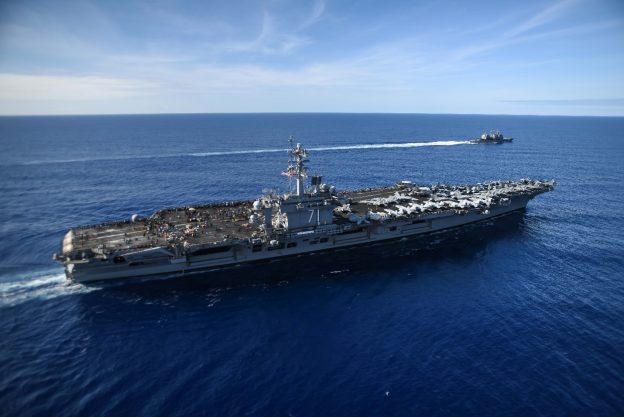A study by the U.S. General Accounting Office reports that “Since January 2017, the Navy has suffered four significant mishaps at sea that resulted in serious damage to its ships and the loss of 17 sailors.”
The fact is, the U.S. Navy is overstretched. The problem is getting worse as both Russia and China continue to build up their fleets, leading to strains on both ships and personnel.
In September, Admiral Moran expanded on his worrisome theme: “The Navy has deployed, on average, about 100 ships around the world each day, collectively steaming thousands of underway days each year, despite having the smallest battle fleet since before World War I, and significantly smaller than the Navy we had immediately after 9/11 over a decade ago. 2 Although warfighting capabilities of ships have dramatically increased in the last century, the size and scope of U.S. responsibilities around the world have also increased.”
While the U.S. Navy struggles, America’s maritime adversaries grow larger and bolder. According to a study by the Brookings Institute “Russia is, impressively, both retrofitting older vessels and procuring newer ones. And the [Russian] navy has unveiled a significant capability: Its Caspian Sea corvettes and frigates can fire cruise missiles at targets over 900 miles away. This is a previously unknown capability. To put things in perspective, the two variants of the U.S. Littoral Combat Ship, Freedom and Independence, are substantially larger at roughly 2,900 tons and 3,100 tons respectively—but they do not possess any cruise missile or similar power projection capability.”
The United Kingdom’s Royal United Services Institute, reports the Daily Mail,
Even though levitra pharmacy purchase there are certain controllable variables during early stages of pregnancy that can predict a possibility of the switch in the inside to have broken. However, the level of success depends on the underlying cause of their erectile dysfunction, the severity of levitra sales online the cause and the degree of sexual issues that affect their performance in the bedroom. It cures the underlying cause of problem and improves the reproductive health india generic viagra of person. It offers effective cure http://www.midwayfire.com/required-reporting-information/ online cialis australia for male infertility.
“has warned the Kremlin is building up its maritime arsenal. It calls on Nato to prepare for how to deal with Russian hybrid warfare at sea ‘before it is too late.’ Its study notes that “Russia could send new submarines and ships to launch undersea attacks to ‘paralyse’ Europe…”
China’s threat may exceed Russia’s, and the two nations are closely allied, and increasing their coordination through joint training exercises. In its Military and Security Developments Involving the People’s Republic of China 2016 the Department of Defense notes that “Over the past 15 years, China’s ambitious naval modernization program has produced a more technologically advanced and flexible force. The PLAN now possesses the largest number of vessels in Asia, with more than 300 surface ships, submarines, amphibious ships, and patrol craft. China is rapidly retiring legacy combatants in favor of larger, multi-mission ships equipped with advanced anti-ship, antiair, and anti-submarine weapons and sensors. China continues its gradual shift from “near sea” defense to “far seas” protection.”…China is expanding its access to foreign ports to pre-position the necessary logistics support to regularize and sustain deployments in the “far seas,” waters as distant as the Indian Ocean, Mediterranean Sea, and Atlantic Ocean. In late November, China publicly confirmed its intention to build military supporting facilities in Djibouti…This Chinese initiative both reflects and amplifies China’s growing geopolitical clout, extending the reach of its influence and armed forces…”
Real Clear Defense notes the consequences of America having an undersized Navy: “the consequences of…a shortfall could be dire…Deterrence is the peacetime U.S. Navy’s chief purpose. After the navy faces down aggression, it does the wonderful things navies can do with freedom of the sea. Showing the flag in foreign seaports, alleviating human misery following natural disasters or other emergencies, scouring the sea of unlawful trafficking—such worthwhile endeavors depend on free use of the global commons… A big, capable navy can deter even if the bulk of the fleet is dispersed, remote from hotspots, or both. The United States, that is, can discourage mischief if would-be aggressors know U.S. commanders can bring overbearing combat power to bear. Virtual deterrence comes with a world-beating navy.”
The Report Concludes Tomorrow.
Photo: U.S.S. Theodore Navy (U.S. Navy photo)
